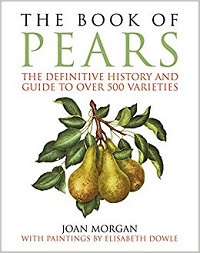
“The Book of Pears” is primarily a meticulous history book. Author Joan Morgan traces the human pursuit and usage of the pear from the empires of Persia, Greece, and Rome to the culinary heights of industrial Europe, especially in Italy, France, England, and Belgium. This British author does not ignore North America, as from the late 19th century on the story of the pear becomes global in scope.
Will this book help you with growing pears? Somewhat, with a brief cultivation section, but better help is found in the extensive directory of varieties, as the choices you need to make will influence your cultural decisions. Do you prefer early fruits which often don’t hold so well? Or good keepers that fruit late? Will these pears be used for eating fresh, canning, for cooking, or for making perry (the pear equivalent of cider)?
If you have a tree of unknown variety, another section on pear Identification may help. Presented in a chart, pear varieties are classified by season and by shape, including pyriform, the traditional pear silhouette, although pears come in many shapes. Further identifiers include color (everything from near white to deep red, including flushes of a deeper color), size, and the amount of russeting or spotting.
As any fruit shopper knows, there are pears and then there are Asian pears. The latter is given some consideration in this book. Each type probably developed separately, one in modern day Iran and eastern Turkey, the other in the Yangtze Valley, from two different wild species. There is evidence of hybridization between the two forms as early as the fifth century CE, but this possibly occurred much earlier.
Throughout the book are 40 stunning plates showing varieties of pears, including the fruit, both unripe on the tree and ripe and sliced for eating, along with the fresh leaves and flowers of spring. These works by Elisabeth Dowle are worthy of a folio book on their own, as they would benefit from presentation in a larger size.
This is an excellent book, I only wish it had been printed in a bigger format, partly for the beauty of the plates, and also to make the minutiae of detail, especially in the directory, more readable.
Excerpted from the Fall 2016 Arboretum Bulletin.